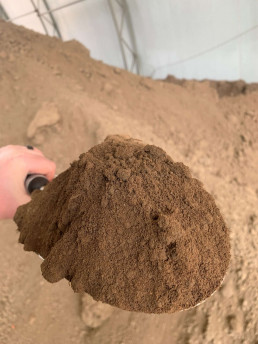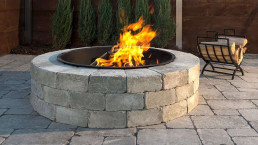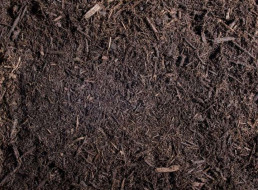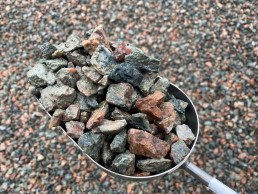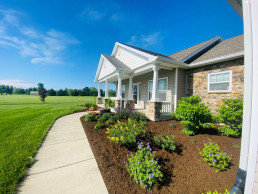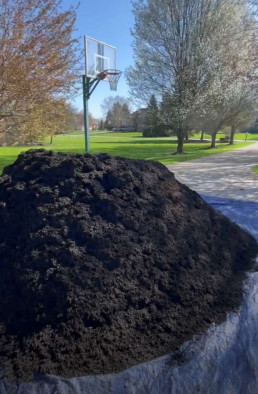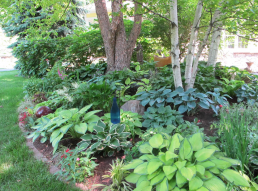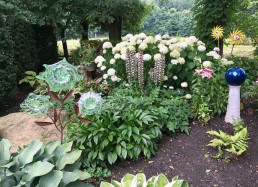Why You Should Order Bulk Topsoil This Season
Why You Should Order Bulk Topsoil This Season
Beautiful landscaping starts with high-quality soil. It’s a crucial piece of the gardening and landscaping puzzle. But buying topsoil can be a frustrating process—from calculating the amount needed, to determining which type is best or how to haul it home, it’s tough without a little expert help. That’s why we’re sharing a secret: buy it from us!
Greendell Landscape Solutions makes buying bulk topsoil fast and simple, helping save time and money on any project.
Higher-Quality Topsoil
Topsoil is essential for providing vegetation with vital nutrients, helping retain moisture, and improving drainage. Long-term, using high-quality product can ensure it doesn’t become compacted and can help prevent erosion.
To ensure Greendell’s topsoil is of the highest quality for our customers, we undergo a thorough testing process to guarantee our topsoil is healthy and does not contain any environmentally damaging ingredients that could potentially lead to landscape degradation.
Using topsoil ordered in bulk can also help provide better results than buying by the bag, as buying in bulk means there’s a chance to check the soil when it’s delivered to make sure it’s free of loose materials or even mold.
Cost of Bulk Topsoil
The cost of product can vary, but Greendell offers the highest-quality topsoil for less than individual bags, even for individual landscaping projects. Greendell’s bulk topsoil is available in amounts that are optimal for a typical yard or home garden, and that means paying bulk prices for even smaller, personal projects.
Buying in bulk also reduces the risk of overbuying, so money isn’t wasted on unused product.
Order Bulk Topsoil
It can be tricky to calculate the precise amount of topsoil needed for a specific project, especially with bagged soil.
Greendell Landscape makes ordering bulk topsoil simple. Use the convenient mulch and soil calculator to determine how much is necessary, place the order, and set the delivery date. It’s that simple. Save time and money and buy bulk mulch this spring at Greendell Landscape.
3 Reasons to Buy the Sunset Firepit Kit This Season
3 Reasons to Buy the Sunset Firepit Kit This Season
Looking for a way to enjoy the outdoors with friends and family this winter season? Unilock’s Sunset Firepit Kit could be the perfect solution. From simple installation to versatile style and design options, the Sunset Firepit Kit fits seamlessly into any type of landscape—sure to make guests feel welcomed and cozy. Here are three key reasons this purchase is worth the investment!
1. Variety in Design
The Sunset Firepit Kit comes in a wide variety of materials and colors, including Coffee Creek, Granite, Sandstone, and Sierra. With simple, clean, and timeworn details, this product is an elegant and sophisticated must-have for backyard get-togethers. Especially when the cooler temperatures start rolling in!
2. Year-Round Enjoyment
A beautiful fire pit is much more than just a seasonal amenity for mild spring or summer nights. Once the cold weather arrives, nothing compares to cozying up and enjoying the warmth of an outdoor fire pit.
The Unilock Sunset Firepit Kit presents plenty of options for entertainment and fun around the fire in the middle of winter or on a cool summer night. Whip up some s’mores and create a warm and cozy ambiance. Unilock’s Sunset Firepit Kit guarantees an elevated landscape experience.
3. Easy Installation
Finally, the best reason of all. Unilock’s Sunset Firepit Kit is simple to order and is delivered with all the tools necessary to begin your installation. When you buy one of our kits, you’ll get:
- Three layers of units to compose firepit dimensions of 51.25” x 51.25” x 12”.
- Two 10-ounce tubes of high-temperature adhesive that works in a traditional household caulk gun. Don’t have one? No problem—purchase one to be delivered with your order here!
- One steel insert to guide the building process and protect your investment.
For a simple, step-by-step walk-through of the installation process, consult our user-friendly guide here.
The search for an ideal firepit ends here. With straightforward installation and effortless assembly, Unilock’s Sunset Firepit Kit adds an additional layer of beauty and a high-quality aesthetic to your landscape design.
Don’t forget to check out our robust selection of mulch products here to get a head start on the spring mulching season!
Benefits of the Forrest Fines® Hardwood Bark Mulch
Benefits of the Forrest Fines® Hardwood Bark Mulch
Still looking for the perfect type of mulch to add to the landscape? If ease of installation and a nutrient-rich soil environment are your top priorities, then Greendell’s Forrest Fines® Hardwood Bark Mulch could provide the perfect solution.
Benefits of Hardwood Bark Mulch
Because of its irregularly sized pieces and rugged style, hardwood bark-style mulch can give landscape beds a more natural and pleasurable appearance and is an excellent choice for a new landscape. Plus, unlike other mulches, hardwood bark provides brilliant color and added dimension to any landscape.
Hardwood bark mulch does an excellent job of protecting the soil against evaporation and helps aerate the soil by allowing air to easily flow in and out. It also offers several other advantages, including:
- Easy spreading and installation
- Breaking down over time to restore soil nutrients
- Boosting vitality for plants requiring a greater amount acid absorption such as azaleas, evergreens, and magnolias
Why Choose Greendell’s Forrest Fines® Hardwood Bark Mulch
Forrest Fines® Mulch is a triple-shredded bark mulch manufactured from bark stripped from the tree during the logging process. That unique process means Forrest Fines® Mulch delivers unmatched quality and measurable upgrades to any landscape.
In fact, Greendell’s Forrest Fines® Mulch has the power to restore the most nutrients to the landscapes it covers compared to other mulch offerings and can also enhance the beauty and vitality of those recently planted flowers in the garden!
Most important, Greendell’s Forrest Fines® Mulch is all natural and contains no dyes. Instead, the mulch has undergone an elaborate aging process, helping it exude a more naturally occurring darker color.
How Much Mulch to Buy?
Still deciding on how much of our Forrest Fines® Mulch to buy? Greendell’s bulk mulch calculator can help identify the precise amount needed for any project. Simply enter the project dimensions and the mulch calculator will help determine the exact quantity to buy—removing the tedious, time-consuming guesswork during check-out, ensuring an easy process for all your mulching needs!
If you’re looking for a mulch that’s easy to install with the unique advantage of restoring nutrition to your soil, consider Greendell’s Forrest Fines® Hardwood Bark Mulch for your next project!
3 Reasons to Buy Decorative Stone this Season
3 Reasons to Buy Decorative Stone This Season
Looking for a way to add some style to your landscape without the hassle of replacing the mulch each season? Greendell’s decorative stone could provide the perfect alternative to mulch and even enhance your own unique landscape vision.
Decorative Stone is Cost-Effective
Thanks to its long lifespan, decorative stone is extremely low maintenance and rarely requires replacing—unlike mulch, which often demands routine maintenance each season. This means that decorative stone is less expensive than mulch in the long run.
Decorative Stone Serves Many Purposes
Decorative stone comes in various shapes, sizes, and colors that serve several different functions for any landscape and offers unlimited opportunities for creative design, including:
- Replacing mulch in and around walkways, ponds, and other water features
- Providing a strong structural base for patios and outdoor living spaces
Decorative Stone Ensures a Healthy Garden
Because decorative stone does not decay or decompose, it lasts much longer than mulch. This means there’s less risk of damaging those freshly planted flowers in the beds each time mulch is replaced. Decorative stone is excellent for keeping weeds away for a long period of time when an appropriate landscape fabric is installed underneath the stone.
How Much Decorative Stone do I Buy?
Unsure of how much decorative stone to buy? Greendell’s bulk stone calculator helps identify the exact amount necessary for any project—just by entering in the project dimensions. Not only does this remove tedious and time-consuming guess work, but it also guarantees an easy, one-stop shop that saves you countless trips to the store.
Next time you need to replace your mulch, consider substituting in a layer of decorative stone instead. Thanks to its long lifespan, multi-functionality, and endless design capabilities, decorative stone is a fantastic alternative to mulch that’s guaranteed to keep your landscape healthy and beautiful for years to come!
How Landscape Mulch Should Season
How Landscape Mulch Should Season
Mulching may not be top of mind in the late summer months but protecting flower beds before the cold weather settles in can help the landscaping return bigger, better, and more beautiful in the spring.
By late summer, landscape mulch in the flower beds may be fading or thinning out, which leaves plants and soil exposed to the elements. Without sufficient coverage, plants that are exposed to repeated freeze-thaw can’t go into hibernation—which is necessary for their survival during the cold winter months.
Adding just a small layer of mulch at the end of summer or early fall can help eliminate that risk and protect the landscaping, even when temperatures begin to drop.
Fall Landscaping
While turning over the mulch can refresh the landscaping’s appearance, it doesn’t do much to protect the soil or plants from the elements. With just one-third the amount needed in the spring, this additional layer of mulch can help protect the landscaping and soil from seasonal changes.
Unlike spring projects which require two to four inches of mulch, fall mulching requires much less—just about one inch will help protect the soil during the winter months.
Not sure how much mulch to buy? The Greendell Mulch Calculator makes it easy, using the length, width, and depth to generate how many yards of mulch a project needs.
Benefits of Fall Mulching
Even in milder winter climates, plants, soil, and other vegetation need protection from the elements. Refreshing the top layer of mulch that’s broken down over time can help insulate soil and encourages microbe growth, which ultimately improves the soil.
Using Greendell mulch in the fall can help:
- Prevent erosion
- Protect plants from extreme temperatures
- Improve soil structure
- Conserve soil moisture
- Suppress weeds
- Enhance the beauty of plantings in flower beds
When cooler temperatures start moving in, consider adding a layer of mulch to your landscaping. Protecting the soil from temperature swings throughout the cold winter months will help plants grow back healthy and strong in the spring.
Pruning Shrubs- why, when, and how!
Though pruning shrubs strikes fear into the hearts of many, it is actually a simple and rewarding process. All you need to do to master it is to understand a few basic principles behind the why, when, and how of pruning shrubs. Once you implement these ideas and techniques, you'll have more flowers and healthier plants in your garden that same season.
Why should I prune a shrub?
When in doubt, don't prune! Most shrubs don't require regular pruning in order to be healthy and beautiful. When you consider pruning a shrub in your yard, first ask yourself why you want to prune it. Every subsequent decision you'll make in pruning depends on the reason why you are pruning in the first place, so never prune without a reason. Reasons you may want to prune a shrub:
- Improve flowering and fruiting
- Improve stem color on plants like dogwood
- Improve the plant's habit or shape
- Encourage rebloom
- Neaten a plant's appearance by removing old blooms or wayward shoots
- Rejuvenate or shorten an over-grown shrub
- Create a special feature, like a topiary or formal hedge
Most shrubs have an appealing natural habit that doesn't require extensive trimming and shaping. Enjoy you low-maintenance landscape and only prune when necessary.
When do I prune a shrub?
To answer this depends on whether the shrub in question blooms on old wood or new wood.
Old Wood
- Shrubs that bloom on old wood create their flower buds for the next year almost as soon as they finish blooming during the current year. Shrubs that bloom on old wood have flower buds present for most of the year.
- Plants that bloom on old wood should only be pruned immediately after they flower:
- Azalea, Deutzia, Elderberry, Forsythia, Lilac, Loropetalum, Ninebark, Pearl-bush, Quince, Spirea (blooms on new wood, but prune after flowering for best foliage display), Weigela
- Generally speaking, the earlier in spring a plant blooms, the more likely it flowers on old wood. If you are willing to forgo flowers for a year, it's okay to prune shrubs that bloom on old wood in the spring.
New Wood
- Shrubs that bloom on new wood create their flower buds for the year after new growth has begun in spring. Shrubs that bloom on new wood have flower buds present only during the growing season. Plants that bloom on new wood may be pruned in spring:
- Bluebeard, Butterfly bush, Coral berry, Diervilla, Smooth hydrangea, Panicle hydrangea, Potentilla, Red-twig dogwood (blooms on old wood, but best pruned in early spring for longest recovery period), Rose of Sharon, Rose
- Try to time pruning such plants so you do it just as the new growth is beginning to emerge on the stems - this allows you to see exactly where healthy new growth is occurring.
Special Cases
- Reblooming plants like Bloomerang lilac and Bloom-A-Thon azalea flower on both new and old wood - if they require pruning. the best time to do it is immediately after the spring bloom.
- Evergreens like arborvitae and boxwood are best pruned in spring, after new growth has flushed out.
- Dead wood can be removed any time. Branches that cause a hazard to people, pets, or property should be removed promptly.
Avoid Pruning
- For best performance, it's best to avoid pruning the following plants, except to remove dead wood in spring.
- Bigleaf hydrangea, mountain hydrangea, oakleaf hydrangea, rhododendron, viburnums grown for their berries, winterberry holly
How do I prune a shrub?
- Use a pair of sharp bypass pruners for the job. Their scissor-like action makes nice clean cuts.
- Cut stems back to just above a big bud or set of buds. The bigger the bud you cut back to, the thicker and more vigorous the growth that comes from it will be.
- When cutting a stem back, avoid cutting into heavy wood where you can't see any buds.
- Make pruning cuts as small as possible by cutting stems straight across instead of on an angle. This ensures speedy healing.
- Aim to remove about one-third of the plant when pruning. There are two main approaches:
- Cut back the entire plant more or less evenly. This shortens the stems and ensures that the growth for the year comes from big, vigorous buds further down on the plant.
- Remove selected stems entirely. This encourages new growth from the base of the plant, improving the health and habit.
Written by Stacey Hirvela for Proven Winners. Original article linked here.
How Much Mulch Do I Need?
How Much Mulch Do I Need?
Adding mulch to a landscape is a simple, effective way to spruce things up without a making a complete overhaul—but figuring out how much mulch is needed for a specific project can feel overwhelming.
Figuring out the right amount of mulch for a project doesn’t have to end with multiple trips to the store and overspending on mulch that goes unused.
Utilizing the Greendell mulch calculator, any mulching job becomes a breeze—by customizing results to each project, based on project size, depth, and the desired aesthetic.
Why use mulch?
Mulch provides a wide range of benefits, like helping soil retain moisture, even in the coldest winter months, and preventing weeds from sprouting up around landscaping. It can be found in a wide array of colors and materials, including plastic, rubber, and wood.
Once the type of mulch is chosen, it’s time to calculate the amount of mulch needed.
How many bags of mulch in a yard?
Greendell+Musselman’s bulk mulch is available by the cubic yard. One cubic yard of mulch is equal to 27 feet—so, a space 30 feet in length, 20 feet in width, and three inches deep would require six cubic yards of mulch.
But figuring out that calculation for any unique space is simple, thanks to the Greendell mulch calculator. Just enter the dimensions where mulch will be spread, and the mulch calculator helps calculate the precise amount necessary for any project—large or small.
For most projects, two-to-three inches of mulch is ideal, to help protect the soil underneath from freezing in the winter or getting too hot in the summer months—helping plants grow back richer and healthier each season.
Start Mulching
Mulch is an affordable way to easily spruce up any landscape and provides long-term protection from the elements and invasive weeds. Greendell makes getting started simple—providing the right tools and expertise for any project.
3 Reasons Why You Should Order Bulk Mulch
3 Reasons Why You Should Order Bulk Mulch
Mulching projects can be exciting—and at times overwhelming at first. Attempting to calculate how much mulch is needed, taking repeated trips to the store, and hauling those heavy bags can seem like a big task to take on—which is why buying in bulk is typically the best option.
Bulk mulch is a convenient, cost-effective way to get the job done—no hauling, no heavy lifting, and expert guidance to see any project through.
Bulk Mulch Delivery—Fast, Convenient, Simple
When it comes to ordering mulch, thinking about carrying those bags around can seem like a lot. Ordering in bulk makes calculating how much mulch is needed much easier and alleviates the risk of overspending and overbuying – guaranteeing a one-stop shop for all your mulching needs.
Repeatedly loading and unloading mulch can be physically taxing on the body – and a major deterrent to mulching. With full-service delivery for bulk mulch—there’s no burden of lifting and taking on this arduous process alone.
Buying Bulk Mulch is Cost-Effective
Ordering bulk mulch is made even easier through the Greendell mulch calculator, allowing customers to input their precise mulch specifications into the designated fields. This information helps determine the exact amount of mulch needed to finish the project—without overbuying or ending up short.
In knowing the exact amount of mulch required for a project, customers can easily sidestep the inconvenience of taking multiple trips to the store and wasting money on arbitrary amounts of mulch they may not even need.
That’s why ordering mulch in bulk is the most reliable option for landscaping projects. There’s no unnecessary back and forth to the store or wasteful spending – there’s only a single delivery.
Plus, ordering bulk mulch gains you access to an arsenal of exclusive mulching tools – unavailable for order on their own – that can completely change the way you install your mulch.
The Right Tools to Get it Right
Customer service goes a long way, and getting a project done right means having the right tools and information to make any mulching project come to life.
Bulk mulch is an ideal option for large projects, small flowerbeds, and everything in between and every bulk mulch order includes comprehensive delivery service.
Does the mulch need to be closer to the basketball hoop, near the mailbox, or next to the sidewalk? With bulk delivery service also comes a dedication to keeping promises and completing orders with perfect execution.
Best of all, the threshold a mulch order requires to be designated as “bulk” is kept at a level that can accommodate a wide range of order sizes.
How to Buy in Bulk
Ordering bulk mulch saves time and ensures the right amount of mulch is delivered for every project—and always includes exclusive installation tools, not available anywhere else.
Interested in buying bulk mulch? Click here to start the process and initiate the first step in beautifying your landscape!
Perennials for Low Maintenance Gardens
Perennial gardens don't have to be so time intensive if you choose to grow at least a few varieties that require little maintenance each season. Here are our top recommendations, all stocked in our Garden Center.
False Indigo
One of the longest-lived perennials native to the American prairies is Baptisia, commonly known as false indigo. While most wild forms are quite tall, the Decadence series from Proven Winners brings them down to just 2-3' tall and wide, about the size of a clump of daylilies. Now everyone can have the fun of growing false indigo, even if you are gardening on smaller city lots.
False indigo is very drought tolerant once established, so you'll only need to provide supplemental water during times of extended drought. It thrives in full sun and hot weather, and does not require fertilizing or deadheading. In fact, if you do cut off the spent blooms, you'll be preventing the formation of its decorative seed pods. So just plant it, then leave it be and it will be fabulous! Zones 4-9 and stocked at Greendell.
Baby's Breath
Who knew baby's breath could be so easy to grow? Old-fashioned varieties gave this perennial a reputation for being a hassle int he garden sine they grew very large and often went dormant by late summer, leaving a big hole in the garden. Festival Star from Proven Winners is a game changer. This improved selection blooms from late spring into fall without deadheading or going summer dormant, and its shorter 12-18" height is easy to manage.
When you plant baby's breath, be sure to amend your soil if it is heavy clay since this plant needs good drainage to grow well. Plant it in a very sunny spot and let it dry out a bit before you water it again. Just like we don't like to sit around in wet shoes, its roots don't like to sit in wet soil for long either. Don't forget to clip some of its fragrant blooms for your fresh or dried bouquets. New flowers will quickly take their place. Zones 3-9 and stocked at Greendell.
Lavender
Sweetly fragrant lavender is always a crowd please, and it's easy to see why. The rich violet purple flowers of lavender bloom from early summer through fall, with new flowers appearing throughout the growing season. They are perfect for using in bouquets, sachets, sweet treats, and lemonade.
Sweet Romance Lavender by Proven Winners is very easy to grow in a sunny, dry spot in your landscape. Planting it in sandy or very well-drained soil will help it grow vigorously and overwinter well in zones 5-9. It does not require fertilization. Trim the foliage back lightly in the spring only if necessary to tidy up the plant. Stocked at Greendell.
Daylily
Even if you don't consider yourself a gardener, chances are good that you've recognized daylilies blooming around town in the summer. One reason why so many people grow them is because they require almost no maintenance other than watering. They multiply reliably year to year, are long lived, and easy to share with neighbors and friends.
Choose from purple, yellow, red, orange, peach, or bicolor varieties. When you plant daylilies, everyday beings fresh flowers to enjoy. Zones 3-9 and stocked at Greendell.
Catmint
Catmint is one of the most requested perennials in the garden centers every year in late spring when people start seeing it bloom around town. It forms a mass of vibrant periwinkle purple flowers that is so dense, you won't even see the foliage when it's in bloom. Bees, butterflies, and hummingbirds love catmint.
Cat's Meow from Proven Winners is a lower maintenance selection because unlike larger varieties, it stays in tidy mound without pruning and won't sprawl all over its neighbors. Just be sure to grow it in full sun and very well-drained soil that is on the dry side. This plant loves warm, sunny days and should be one of the last things you water in the garden. Zones 3-8, stocked at Greendell.
Hosta
If you garden in shade, one of the easiest, low maintenance perennials you can grow is a hosta. It's amazing how hostas emerge from bare ground in spring and grow so quickly to fill large spaces with elegant foliage. After the first few frosts in the fall, the foliage will go dormant again until the following spring. Clean up dead foliage in the fall to help prevent slug issues the following year.
Hostas grow best in organically rich soils and tolerate clay well. In the coolest parts of the country, they will survive in sun, but they are happiest when grown under the canopy of tall trees in zones 3-9. Keep the soil evenly moist for best growth. Many varieties stocked at Greendell.
Switch Grass
These durable perennials will thrive in any soil, from sand to clay, and in any moisture level from dry to wet. The only thing they require is full sun. Switch Grasses can be used as a low maintenance screen, hedge, background planting, or as a focal point in the fall landscape.
Once per year in late winter or early spring before the new growth emerges, cut the entire clump of last year's foliage back with hedge trimmers and compost it. Beyond that, no other maintenance is necessary. Zones 4-9. Many varieties stocked at Greendell.
Sedum
When you feel its succulent leaves, you'll see why sedum (stonecrop) is so drought tolerant. It stores water in its foliage and stems as a reserve, and usually doesn't require supplemental water once the roots are established. Plant it in full sun and very well-drained soil, and do not add fertilizer or organic matter when you plant it. Lean and mean is how sedum rolls -- pamper it and you'll be disappointed.
Sedum comes in many sizes, shapes, and colors. Expect most to bloom in late summer and fall, providing a late season pollen source for bees and butterflies. Leave it alone in the fall and then cut any remaining foliage to the ground in early spring, Many varieties stocked at Greendell.
Russian Sage
During the hottest months of summer, the cool blue flowers of Russian sage are a welcome respite in the garden. You'll love how Denim n Lace by Proven Winners forms a dense, upright clump and is completely covered in flowers beginning in midsummer.
Like sedum, Russian sage is not a plant that enjoys pampering. Grow it in very well-drained, sandy, or rocky soil and do not add fertilizer or organic matter when planting it. It enjoys drier soils and rarely requires supplemental water. The only maintenance it should need is cutting the stems back to 3" tall in early spring before new growth appears. Zones 4-9, stocked at Greendell.
Original article published by Proven Winners
Mulching Perennials
Most plants, including perennials, benefit from having mulch around their roots year-round. Organic mulch like shredded bark or hardwood makes our gardens look more polished, but it also serves several useful purposes including:
- Shading the plants' roots and keeping the soil cooler, which makes the roots healthier
- Retaining soil moisture longer
- Preventing weeds from growing up into the plants
- Adding nutrients to the soil as the mulch disintegrates over time
Inorganic mulches like small stones or gravel can also be used, but they will not have the added benefit of enriching the soil since they do not break down. Stone can be useful in very windy locations where lighter mulch tends to blow away and is sometimes used on steep slopes where lighter mulch would wash away. Just beware that if you ever decide to switch from stone to organic mulch, it is back breaking work to remove those stones.
Whichever type of mulch you use, it is important to prevent it from touching the crown (base) of the plant. Spread your mulch carefully so that is lays nicely under your plant's foliage but away from the crown. When mulch touches the crown, it is an invitation for plant rot and pest issues.
If you plant any perennials or shrubs in the fall, be sure to lay a 3-4 inch layer of mulch around them to prevent frost heaving during the winter months. The mulch will moderate the soil temperature so it remains consistent throughout the winter.
Perennial gardens benefit greatly from having a layer of shredded leaves placed over them in late fall or early winter after the plants have gone dormant. When you are raking earlier in the fall, shred and bag some of our leaved to use for this purpose. By spring, the shredded leaves in your garden beds will have mostly broken down and their nutrients will enrich the soil -- it's free fertilizer!
Original article written by Susan Martin and published by Proven Winners.
